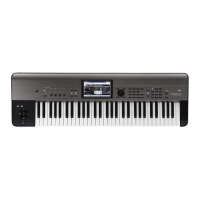PROG P3: Filter 3–1: Filter1
27
Filter Types and Cutoff Frequency
Bypass [Off, On]
This lets you bypass Filter A completely.
If Bypass is Off, Filter A functions normally.
When Bypass is On, Filter A will have no effect.
Frequency [00...99]
This controls the cutoff frequency of Filter A, in increments
of 1/10 of an octave. The specific effect of the cutoff
frequency will change depending on the selected Filter
Type.
Trim [00...99]
This adjusts the volume level at the input to the filter. If you
notice that the sound is distorting, especially with high
Resonance settings, you can turn the level down here, or at
the Output.
Resonance [00...99]
Resonance emphasizes the frequencies around the cutoff
frequency.
When this is set to 0, there is no emphasis, and frequencies
beyond the cutoff will simply diminish smoothly.
At medium settings, the resonance will alter the timbre of
the filter, making it sound more nasal, or more extreme.
At very high settings, the resonance can be heard as a
separate, whistling pitch.
To make the resonance track the keyboard pitch, please see
“Key Follow” on page 29.
AMS (Resonance) [List of AMS Sources]
This selects a AMS source to control the Resonance amount.
For a list of AMS sources, please see “AMS (Alternate
Modulation Source) List” on page 340.
AMS Int. [–99...+99]
This controls the depth and direction of the Resonance
modulation.
For example, if Velocity has been selected, changes in
keyboard velocity will affect the resonance. With positive (+)
values, the resonance will increase as you play more
strongly, and as you play more softly the resonance will
approach the level specified by the Resonance setting. With
negative (–) values, the resonance will decrease as you play
more strongly, and as you play more softly the resonance
will approach the level specified by the Resonance setting.
The resonance level is determined by adding the Resonance
and AMS Int. values.
Output [00...99]
This controls the output level of Filter A. You can use this to
balance the volumes of Filters A and B when the Routing is
set to Parallel, or to turn down the volume to avoid clipping
later in the signal chain.
AMS (Output AMS) [List of AMS Sources]
This selects a modulation source to control the output level
of Filter A. For a list of AMS sources, please see “AMS
(Alternate Modulation Source) List” on page 340.
AMS Int. [–99...+99]
This controls the depth and direction of the output level
modulation.
3–1c: Filter B
Filter B is available when the Filter Routing is set to Serial
or Parallel. Otherwise, the parameters in this section will be
grayed out.
The parameters for Filter B are identical to those for Filter A.
For more information, please see the descriptions under
Filter A, above.
V
3–1: Menu Command
•0: Write Program see p. 64
•1: Exclusive Solo see p. 64
•2: Auto Song Setup see p. 65
•3: Copy Oscillator see p. 65
•4: Swap Oscillator see p. 65
For more information, please see “Program: Menu
Command” on page 64.
Low Pass
High Pass
Band Pass
Band Reject
Low resonance value High resonance value

